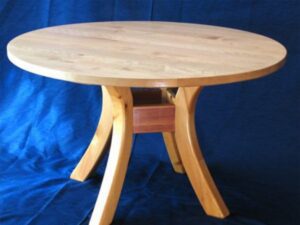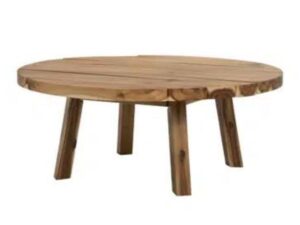Sanding rounded table legs can be a challenging task, but with the right techniques and tools, you can achieve a smooth and professional finish. Whether you’re refinishing an old table or working on a DIY project, proper sanding is essential for enhancing the aesthetics and durability of the table legs. In this article, we will guide you through the step-by-step process of how to sand rounded table legs, from assessing the condition of the legs to applying a protective finish. Let’s get started!
Tools And Materials Needed For Sanding Rounded Table Legs
Before diving into the sanding process, gather the necessary tools and materials. These may include sandpaper in various grits, sanding blocks or pads, a sanding sponge, a power sander (optional), safety goggles, a dust mask, a tack cloth, wood filler, a putty knife, and a finish of your choice. Having the right tools at hand will ensure efficiency and precision throughout the sanding process.
Safety Precautions for Sanding Rounded Table Legs
Safety should always be a priority when working with power tools and sanding materials. Wear safety goggles to protect your eyes from flying debris, and use a dust mask to avoid inhaling sawdust particles. Additionally, work in a well-ventilated area to minimize dust accumulation. Keep your workspace clean and organized, and be cautious when handling sharp tools or power sanders. Following these safety precautions will help prevent accidents and ensure a safe sanding experience.

Understanding The Different Types Of Wood Used For Table Legs
Table legs can be crafted from various types of wood, each with its unique characteristics. Common wood species used for table legs include oak, pine, maple, mahogany, and cherry. Understanding the properties of the wood you’re working with can help you determine the appropriate sanding techniques and finishing methods. Different woods may require specific considerations, such as the grain pattern, hardness, or vulnerability to damage, so research and familiarize yourself with the specific wood type before proceeding.
Assessing The Condition Of The Table Legs Before Sanding
Before beginning the sanding process, carefully inspect the condition of the table legs. Look for any cracks, splinters, dents, or scratches that may need repair or additional attention. Assessing the condition of the wood will help you determine the extent of sanding required and whether any pre-sanding preparations or repairs are necessary. Taking the time to thoroughly examine the legs will ensure a more effective and efficient sanding process.

Choosing The Right Grit Sandpaper For The Job
Selecting the appropriate grit sandpaper is crucial for achieving desired results. For initial sanding or removing rough surfaces, start with a coarser grit, such as 80 or 100. As you progress, move to finer grits, like 150, 220, or even higher, for a smoother finish. The specific condition of the table legs and the desired level of smoothness will dictate the sequence of grits you should use. Remember to replace the sandpaper regularly to maintain optimal effectiveness.
Properly Securing The Table Legs For Sanding
To facilitate effective sanding, it’s essential to secure the table legs firmly. If the table is still intact, you can place it upside down on a stable surface and use clamps to hold it in place. Alternatively, if the legs are detached or you prefer to work on them separately, consider using a workbench or a sturdy table vise to secure them firmly. This stability will ensure better control and minimize the risk of accidents while sanding.
Techniques For Sanding The Curved Surfaces Of Table Legs
Sanding curved surfaces requires special techniques to achieve an even and consistent finish. One effective approach is to use a sanding sponge or a sanding block wrapped with sandpaper. The flexibility of these tools allows for better conformity to the curved contours of the legs. Move the sandpaper in a circular or back-and-forth motion, following the natural shape of the legs. Take your time and apply even pressure to avoid creating flat spots or uneven surfaces.

Removing Existing Finishes and Stains from the Table Legs
If the table legs have existing finishes or stains, it’s important to remove them before sanding. Use a paint stripper or a chemical stripping agent as directed, applying it with a brush and allowing it to penetrate the finish. Once the finish has softened, scrape it off using a putty knife, being careful not to gouge the wood. Repeat the process as necessary until the old finish or stain is completely removed. This step prepares the surface for effective sanding and allows for a fresh start.
Dealing With Intricate Details And Carvings On The Table Legs
Table legs often feature intricate details, carvings, or delicate areas that require special attention during sanding. In such cases, it’s advisable to use smaller tools like sanding sponges, sandpaper wrapped around pencils or dowels, or even toothpicks to reach tight spots. Patience and precision are key when working on intricate areas, ensuring that all surfaces are properly smoothed and prepared for the finishing stage.
Sanding Tips For Achieving A Smooth And Even Surface
To achieve a smooth and even surface on the table legs, follow these helpful tips:
- Start with a coarse grit and gradually progress to finer grits.
- Sand in the direction of the wood grain to prevent scratches.
- Apply even pressure and maintain a consistent sanding motion.
- Check the surface regularly to ensure uniformity and address any imperfections promptly.
- Avoid excessive sanding in one area to prevent creating uneven surfaces or divots.
- Clean the surface between grit changes to remove dust and debris.

Addressing Any Dents, Scratches, Or Imperfections In The Wood
During the sanding process, you may encounter dents, scratches, or other imperfections in the wood. To address these issues, use a wood filler or putty that matches the color of the wood. Apply the filler using a putty knife, ensuring that it fills the imperfection completely. Once dry, sand the area lightly to level it with the surrounding wood. This technique will help restore the smoothness and integrity of the table legs.
Transitioning Between Different Grits For Optimal Results
As you progress through the sanding process, transitioning between different grits is crucial for achieving optimal results. Each grit smooths the wood surface and removes the scratches left by the previous grit. When transitioning to a finer grit, make sure to sand until the marks left by the coarser grit are completely eliminated. This gradual refinement will result in a polished and flawless finish on the rounded table legs.
Using Sanding Blocks And Pads For Greater Control
Sanding blocks and pads offer enhanced control and stability during the sanding process. They come in various shapes and sizes, allowing you to adapt them to the contours of the rounded table legs. The block or pad acts as a buffer between your hand and the sandpaper, ensuring a more even distribution of pressure. This not only improves sanding precision but also minimizes the risk of accidental flattening of curved surfaces.
Cleaning And Preparing The Table Legs For Finishing
Once the sanding process is complete, it’s crucial to clean the table legs thoroughly before applying any finish. Use a soft brush or a vacuum cleaner to remove all traces of sawdust and debris from the wood surfaces. Follow this by wiping the legs with a tack cloth to eliminate any remaining particles. This cleaning step ensures a clean and smooth surface for the finishing stage.

Applying A Protective Finish To The Sanded Table Legs
After sanding and cleaning, it’s time to apply a protective finish to the sanded table legs. There are various options to choose from, including stains, varnishes, oils, or paints, depending on the desired look and level of protection. Follow the manufacturer’s instructions for the chosen finish, applying it evenly with a brush or a cloth. Allow sufficient drying time between coats, and apply additional layers as needed for the desired finish and durability.
Buffing And Polishing Techniques For A Professional Look
To achieve a professional and polished appearance, consider using buffing and polishing techniques. Once the final coat of finish is completely dry, use a soft cloth or a buffing pad to gently rub the surface in circular motions. This process helps to smooth out any minor imperfections and enhances the sheen of the finish. Take care not to apply excessive pressure or over-buff, as this may remove the finish or create uneven patches.
Common Mistakes To Avoid When Sanding Rounded Table Legs
While sanding rounded table legs, it’s important to avoid some common mistakes that can compromise the quality of your work. Here are a few to watch out for:
- Over-sanding: Excessive sanding can remove too much wood and compromise the structural integrity of the legs. Avoid aggressive sanding and strive for a balanced approach.
- Inconsistent sanding: Uneven sanding can result in an irregular appearance. Maintain consistent pressure and motion throughout the sanding process to achieve a uniform surface.
- Neglecting safety precautions: Always prioritize safety by wearing protective goggles, a dust mask, and following safe operating practices with power tools.
- Skipping grits: Transitioning gradually between grits is essential for achieving a smooth finish. Skipping grits can leave visible scratches or imperfections on the surface.
- Rushing the process: Patience is key when sanding rounded table legs. Rushing can lead to mistakes, uneven surfaces, or incomplete sanding. Take your time and work methodically for the best results.

Troubleshooting Common Challenges During The Sanding Process
Despite careful planning and execution, you may encounter some challenges during the sanding process. Here are a few troubleshooting tips for common issues:
- Streaks or scratches: Check your sandpaper for clogging or wear and replace it if necessary. Also, ensure that you’re using the proper sanding technique and following the grain direction.
- Uneven surfaces: Double-check for consistent pressure and motion while sanding. Pay attention to areas that may need extra attention, such as tight curves or carved details.
- Embedded dust particles: If you notice dust particles trapped in the finish or on the sanded surface, gently sand the affected area with a fine-grit sandpaper to remove the particles. Then, clean and reapply the finish.
Final Tips And Recommendations For Maintaining Sanded Table Legs
Once you’ve successfully sanded and finished your rounded table legs, it’s essential to maintain their appearance and durability. Here are some final tips and recommendations:
- Regularly dust the table legs to prevent the buildup of dirt and debris.
- Use coasters or placemats to protect the legs from spills and heat.
- Avoid dragging or scraping objects across the legs to prevent scratches.
- Periodically inspect the legs for any signs of wear or damage and address them promptly.
- If necessary, reapply a protective finish to maintain the beauty and longevity of the legs.
Conclusion (How To Sand Rounded Table Legs? )
Sanding rounded table legs requires careful attention to detail, proper tools, and techniques. By following the outlined steps, you can transform your table legs into smooth, refined, and visually appealing features. Remember to prioritize safety, take your time, and enjoy the process of transforming your table into a stunning centerpiece. With proper sanding and finishing, your rounded table legs will shine with beauty and craftsmanship for years to come.
FAQs (How To Sand Rounded Table Legs? )
Q: Can I use an electric sander for sanding rounded table legs?
A: While an electric sander can be used, it may be challenging to maneuver on curved surfaces. Hand sanding tools like sanding blocks or sponges offer better control.
Q: How do I know which grit sandpaper to start with?
A: Start with a coarser grit (e.g., 80 or 100) for initial sanding. Adjust the grit depending on the condition of the legs and the desired smoothness.
Q: How can I protect the surrounding area from dust during sanding?
A: Consider setting up a makeshift barrier or working in a well-ventilated area with a dust collection system. Cover nearby furniture or surfaces with drop cloths or plastic sheets.
Q: Can I use wood stain on rounded table legs?
A: Yes, wood stain can be applied to rounded table legs. Ensure the surface is properly sanded and prepared before applying the stain according to the manufacturer’s instructions.
Q: What’s the best way to maintain the sanded table legs over time?
A: Regular cleaning, using protective coasters, and periodically inspecting for any signs of wear or damage are key to maintaining sanded table legs.


2 thoughts on “How To Sand Rounded Table Legs? Explore Now”